Mechanical and Thermal Properties of Recycled Fishing Net-Derived Polyamide 6/Switchgrass Fiber Composites for Automotive Applications
Abstract
:1. Introduction
2. Results
2.1. Isothermal TGA
2.2. DSC
2.3. Dynamic Mechanical Analysis
2.4. Tensile Tests
2.5. Melt Flow Rate
3. Materials and Methods
3.1. Materials
3.2. Preparation of Specimens
3.3. Characterization Techniques
3.3.1. Isothermal Thermogravimetric Analysis (TGA)
3.3.2. Differential Scanning Calorimetry (DSC)
3.3.3. Dynamic Mechanical Analysis (DMA)
3.3.4. Tensile Tests
3.3.5. Scanning Electron Microscopy (SEM)
3.3.6. Melt Flow Rate (MFR)
4. Conclusions
Author Contributions
Funding
Data Availability Statement
Acknowledgments
Conflicts of Interest
References
- Macfadyen, G.; Huntington, T.; Cappell, R. Abandoned, lost or otherwise discarded fishing gear. In UNEP Regional Seas Reports and Studies No. 185; FAO Fisheries and Aquaculture Technical Paper No. 523; UNEP/FAO: Rome, Italy, 2009; Available online: https://www.researchgate.net/publication/242491383_Abandoned_Lost_or_Otherwise_Discarded_Fishing_Gear (accessed on 3 June 2024).
- U.S. Commission on Ocean Policy. U.S. Ocean Action Plan: The Bush Administration’s Response to the U.S. Commission on Ocean Policy. 2004. Available online: https://www.ncei.noaa.gov/data/oceans/coris/library/NOAA/other/us_ocean_action_plan_2004.pdf (accessed on 31 December 2024).
- Lebreton, L.; Slat, B.; Ferrari, F.; Sainte-Rose, B.; Aitken, J.; Marthouse, R.; Hajbane, S.; Cunsolo, S.; Schwarz, A.; Levivier, A.; et al. Evidence that the Great Pacific Garbage Patch is rapidly accumulating plastic. Sci. Rep. 2018, 8, 4666. [Google Scholar] [CrossRef] [PubMed]
- Richardson, K.; Hardesty, B.D.; Wilcox, C. Estimates of fishing gear loss rates at a global scale: A literature review and meta-analysis. Fish Fish. 2019, 20, 1218–1231. [Google Scholar] [CrossRef]
- Breen, P.A. Report of the working group on ghost fishing. In Proceedings of the Second International Conference on Marine Debris, NOAA Technical Memorandum NMFS-TM-NMFS-SWFSC-154, Shomura, Honolulu, HI, USA, 2–7 April 1989; pp. 571–599. [Google Scholar]
- Kondo, M.Y.; Montagna, L.S.; Morgado, G.F.d.M.; de Castilho, A.L.G.; Batista, L.A.P.d.S.; Botelho, E.C.; Costa, M.L.; Passador, F.R.; Rezende, M.C.; Ribeiro, M.V. Recent advances in the use of Polyamide-based materials for the automotive industry. Polímeros 2022, 32, e2022023. [Google Scholar] [CrossRef]
- Nguyen-Tran, H.-D.; Hoang, V.-T.; Do, V.-T.; Chun, D.-M.; Yum, Y.-J. Effect of Multiwalled Carbon Nanotubes on the Mechanical Properties of Carbon Fiber-Reinforced Polyamide-6/Polypropylene Composites for Lightweight Automotive Parts. Materials 2018, 11, 429. [Google Scholar] [CrossRef] [PubMed]
- European Commission. CO2 Emission Performance Standards for Cars and Vans. Available online: https://climate.ec.europa.eu/eu-action/transport/road-transport-reducing-co2-emissions-vehicles/co2-emission-performance-standards-cars-and-vans_en?u (accessed on 31 December 2024).
- Multi-Pollutant Emissions Standards for Model Years 2027 and Later Light-Duty and Medium-Duty Vehicles. Available online: https://www.govinfo.gov/content/pkg/FR-2024-04-18/pdf/2024-06214.pdf (accessed on 31 December 2024).
- Chauhan, V.; Kärki, T.; Varis, J. Review of natural fiber-reinforced engineering plastic composites, their applications in the transportation sector and processing techniques. J. Thermoplast. Compos. Mater. 2022, 35, 1169–1209. [Google Scholar] [CrossRef]
- Uematsu, H.; Kawasaki, T.; Koizumi, K.; Yamaguchi, A.; Sugihara, S.; Yamane, M.; Kawabe, K.; Ozaki, Y.; Tanoue, S. Relationship between crystalline structure of polyamide 6 within carbon fibers and their mechanical properties studied using Micro-Raman spectroscopy. Polymer 2021, 223, 123711. [Google Scholar] [CrossRef]
- Zaldua, N.; Maiz, J.; de la Calle, A.; García-Arrieta, S.; Elizetxea, C.; Harismendy, I.; Tercjak, A.; Müller, A.J. Nucleation and Crystallization of PA6 Composites Prepared by T-RTM: Effects of Carbon and Glass Fiber Loading. Polymers 2019, 11, 1680. [Google Scholar] [CrossRef]
- Mosey, S.; Korkees, F.; Rees, A.; Llewelyn, G. Investigation into fibre orientation and weldline reduction of injection moulded short glass-fibre/polyamide 6-6 automotive components. J. Thermoplast. Compos. Mater. 2020, 33, 1603–1628. [Google Scholar] [CrossRef]
- Caputo, F.; Lamanna, G.; De Luca, A.; Armentani, E. Thermo-Mechanical Investigation on an Automotive Engine Encapsulation System Made of Fiberglass Reinforced Polyamide PA6 GF30 Material. Macromol. Symp. 2020, 389, 1900100. [Google Scholar] [CrossRef]
- Güler, T.; Demirci, E.; Yıldız, A.R.; Yavuz, U. Lightweight design of an automobile hinge component using glass fiber polyamide composites. Mater. Test. 2018, 60, 306–310. [Google Scholar] [CrossRef]
- Ishikawa, T.; Amaoka, K.; Masubuchi, Y.; Yamamoto, T.; Yamanaka, A.; Arai, M.; Takahashi, J. Overview of automotive structural composites technology developments in Japan. Compos. Sci. Technol. 2018, 155, 221–246. [Google Scholar] [CrossRef]
- Joshi, S.V.; Drzal, L.T.; Mohanty, A.K.; Arora, S. Are natural fiber composites environmentally superior to glass fiber reinforced composites? Compos. Part A Appl. Sci. Manuf. 2004, 35, 371–376. [Google Scholar] [CrossRef]
- Patel, M.; Bastioli, C.; Marini, L.; Würdinger, E. Life-cycle Assessment of Bio-based Polymers and Natural Fiber Composites. In Biopolymers Online; Steinbüchel, A., Ed.; Wiley: Hoboken, NJ, USA, 2002. [Google Scholar] [CrossRef]
- Corbière-Nicollier, T.; Laban, B.G.; Lundquist, L.; Leterrier, Y.; Månson, J.-A.E.; Jolliet, O. Life cycle assessment of biofibres replacing glass fibres as reinforcement in plastics. Resour Conserv. Recycl. 2001, 33, 267–287. [Google Scholar] [CrossRef]
- Foulk, J.A.; Akin, D.E.; Dodd, R.B. New Low Cost Flax Fibers for Composites; SAE International: Warrendale, PA, USA, 2000. [Google Scholar] [CrossRef]
- Thomason, J.L.; Rudeiros-Fernández, J.L. Thermal degradation behaviour of natural fibres at thermoplastic composite processing temperatures. Polym. Degrad Stab. 2021, 188, 109594. [Google Scholar] [CrossRef]
- Mondragon, G.; Kortaberria, G.; Mendiburu, E.; González, N.; Arbelaiz, A. Thermomechanical recycling of polyamide 6 from fishing nets waste. J. Appl. Polym.Sci. 2020, 137, 48442. [Google Scholar] [CrossRef]
- Pasciucco, F.; Rossi, D.; Maccaferri, E.; Pecorini, I.; Giorgini, L.; Seggiani, M. Recycling polyamide 6 fishing nets and carbon fibers for the development of novel sustainable composites: Properties and LCA process analysis. J. Clean. Prod. 2025, 486, 144634. [Google Scholar]
- Abdullah, N.; Abdan, K.; Roslim, M.H.M.; Radzuan, M.N.; Shafi, A.R.; Hao, L.C. Properties of kenaf fiber-reinforced polyamide 6 composites. e-Polymers 2024, 24, 20228112. [Google Scholar] [CrossRef]
- Kiziltas, E.E.; Yang, H.-S.; Kiziltas, A.; Boran, S.; Ozen, E.; Gardner, D.J. Thermal Analysis of Polyamide 6 Composites Filled by Natural Fiber Blend. BioResources 2016, 11, 4758–4769. [Google Scholar] [CrossRef]
- Falasca, S.; Pitta-Alvarez, S.; Del Fresno, C.M. Possibilities for Growing Switch-grass (Panicum virgatum) as Second Generation Energy Crop in Dry-subhumid, Semiarid and Arid Regions of the Argentina. J. Cent. Eur. Agric. 2017, 18, 95–116. [Google Scholar] [CrossRef]
- Sahoo, S.; Misra, M.; Mohanty, A.K. Biocomposites From Switchgrass and Lignin Hybrid and Poly(butylene succinate) Bioplastic: Studies on Reactive Compatibilization and Performance Evaluation. Macromol. Mater. Eng. 2014, 299, 178–189. [Google Scholar] [CrossRef]
- van den Oever, M.J.A.; Elbersen, H.W.; Keijsers, E.R.P.; Gosselink, R.J.A.; de Klerk-Engels, B. Switchgrass (Panicum virgatum L.) as a reinforcing fibre in polypropylene composites. J. Mater. Sci. 2003, 38, 3697–3707. [Google Scholar] [CrossRef]
- Ford. Ford Bronco Sport Becomes First Vehicle to Feature Parts Made of 100% Recycled Ocean Plastic. Available online: https://media.ford.com/content/fordmedia/fna/us/en/news/2021/12/08/ford-bronco-sport-recycled-ocean-plastic.html (accessed on 24 January 2025).
- BMW. Recycled Fishing Nets for the Neue Klasse. Available online: https://www.bmwgroup.com/en/news/general/2022/recycled-plastics.html (accessed on 1 January 2025).
- Mercedes Benz. Innovative Materials for Sustainable Luxury. Available online: https://group.mercedes-benz.com/sustainability/resources-circularity/materials/sustainable-materials.html (accessed on 27 February 2025).
- Liang, S.; Nouri, H.; Lafranche, E. Thermo-compression forming of flax fibre-reinforced polyamide 6 composites: Influence of the fibre thermal degradation on mechanical properties. J. Mater. Sci. 2015, 50, 7660–7672. [Google Scholar] [CrossRef]
- Cui, J.; Fu, D.; Mi, L.; Li, L.; Liu, Y.; Wang, C.; He, C.; Zhang, H.; Chen, Y.; Wang, Q. Effects of Thermal Treatment on the Mechanical Properties of Bamboo Fiber Bundles. Materials 2023, 16, 1239. [Google Scholar] [CrossRef] [PubMed]
- Gao, Z.; Wang, X.-M.; Wan, H.; Brunette, G. Binderless panels made with black spruce bark. BioResources 2011, 6, 3960–3972. [Google Scholar] [CrossRef]
- Prins, M.J.; Ptasinski, K.J.; Janssen, F.J.J.G. Torrefaction of wood part 1. J. Anal. Appl. Pyrolysis 2006, 77, 28–34. [Google Scholar] [CrossRef]
- Prins, M.J.; Ptasinski, K.J.; Janssen, F.J.J.G. Torrefaction of wood part 2. J. Anal. Appl. Pyrolysis 2006, 77, 35–40. [Google Scholar] [CrossRef]
- Klata, E.; Van de Velde, K.; Krucińska, I. DSC investigations of polyamide 6 in hybrid GF/PA 6 yarns and composites. Polym. Test. 2003, 22, 929–937. [Google Scholar] [CrossRef]
- Abdullah, N.; Abdan, K.; Lee, C.H.; Roslim, M.H.M.; Radzuan, M.N.; Shafi, A.R. Thermal properties of wood flour reinforced polyamide 6 biocomposites by twin screw extrusion. Phys. Sci. Rev. 2023, 8, 5153–5164. [Google Scholar] [CrossRef]
- Huang, Z.; Yin, Q.; Wang, Q.; Wang, P.; Liu, T.; Qian, L. Mechanical properties and crystallization behavior of three kinds of straws/nylon 6 composites. Int. J. Biol. Macromol. 2017, 103, 663–668. [Google Scholar] [CrossRef]
- Zhu, S.; Guo, Y.; Chen, Y.; Liu, S. Low Water Absorption, High-Strength Polyamide 6 Composites Blended with Sustainable Bamboo-Based Biochar. Nanomaterials 2020, 10, 1367. [Google Scholar] [CrossRef]
- Sambale, A.; Kurkowski, M.; Stommel, M. Determination of moisture gradients in polyamide 6 using StepScan DSC. Thermochim. Acta 2019, 672, 150–156. [Google Scholar]
- Chukov, D.; Nematulloev, S.; Zadorozhnyy, M.; Tcherdyntsev, V.; Stepashkin, A.; Zherebtsov, D. Structure, Mechanical and Thermal Properties of Polyphenylene Sulfide and Polysulfone Impregnated Carbon Fiber Composites. Polymers 2019, 11, 684. [Google Scholar] [CrossRef] [PubMed]
- Cristea, M.; Ionita, D.; Iftime, M.M. Dynamic Mechanical Analysis Investigations of PLA-Based Renewable Materials: How Are They Useful? Materials 2020, 13, 5302. [Google Scholar] [CrossRef] [PubMed]
- Codou, A.; Moncel, M.; van Berkel, J.G.; Guigo, N.; Sbirrazzuoli, N. Glass transition dynamics and cooperativity length of poly(ethylene 2,5-furandicarboxylate) compared to poly(ethylene terephthalate). Phys. Chem. Chem. Phys. 2016, 18, 16647–16658. [Google Scholar]
- Mohammed, M.; Rasidi, M.; Mohammed, A.; Rahman, R.; Osman, A.; Adam, T.; Betar, B.; Dahham, O. Interfacial bonding mechanisms of natural fibre-matrix composites: An overview. BioResources 2022, 17, 7031–7090. [Google Scholar] [CrossRef]
- Bahlouli, S.; Belaadi, A.; Makhlouf, A.; Alshahrani, H.; Khan, M.K.A.; Jawaid, M. Effect of Fiber Loading on Thermal Properties of Cellulosic Washingtonia Reinforced HDPE Biocomposites. Polymers 2023, 15, 2910. [Google Scholar] [CrossRef]
- Sreenivasan, V.S.; Rajini, N.; Alavudeen, A.; Arumugaprabu, V. Dynamic mechanical and thermo-gravimetric analysis of Sansevieria cylindrica/polyester composite: Effect of fiber length, fiber loading and chemical treatment. Compos. B Eng. 2015, 69, 76–86. [Google Scholar] [CrossRef]
- Hameed, N.; Sreekumar, P.A.; Francis, B.; Yang, W.; Thomas, S. Morphology, dynamic mechanical and thermal studies on poly(styrene-co-acrylonitrile) modified epoxy resin/glass fibre composites. Compos. Part A Appl. Sci. Manuf. 2007, 38, 2422–2432. [Google Scholar] [CrossRef]
- Mofokeng, J.P.; Luyt, A.S.; Tábi, T.; Kovács, J. Comparison of injection moulded, natural fibre-reinforced composites with PP and PLA as matrices. J. Thermoplast. Compos. Mater. 2012, 25, 927–948. [Google Scholar] [CrossRef]
- Ornaghi, H.L.; Neves, R.M.; Monticeli, F.M.; Thomas, S. Modeling of dynamic mechanical curves of kenaf/polyester composites using surface response methodology. J. Appl. Polym.Sci. 2022, 139, e52078. [Google Scholar]
- Tham, M.W.; Fazita, M.N.; Khalil, H.A.; Zuhudi, N.Z.M.; Jaafar, M.; Rizal, S.; Haafiz, M.M. Tensile properties prediction of natural fibre composites using rule of mixtures: A review. J. Reinf. Plast.Compos. 2019, 38, 211–248. [Google Scholar] [CrossRef]
- Bakar, N.; Chee, C.Y.; Abdullah, L.C.; Ratnam, C.T.; Azowa, N. Effect of methyl methacrylate grafted kenaf on mechanical properties of polyvinyl chloride/ethylene vinyl acetate composites. Compos. Part A Appl. Sci. Manuf. 2014, 63, 45–50. [Google Scholar] [CrossRef]
- Panyasart, K.; Chaiyut, N.; Amornsakchai, T.; Santawitee, O. Effect of Surface Treatment on the Properties of Pineapple Leaf Fibers Reinforced Polyamide 6 Composites. Energy Procedia 2014, 56, 406–413. [Google Scholar] [CrossRef]
- Alonso-Montemayor, F.J.; Tarrés, Q.; Oliver-Ortega, H.; Espinach, F.X.; Narro-Céspedes, R.I.; Castañeda-Facio, A.O.; Delgado-Aguilar, M. Enhancing the Mechanical Performance of Bleached Hemp Fibers Reinforced Polyamide 6 Composites: A Competitive Alternative to Commodity Composites. Polymers 2020, 12, 1041. [Google Scholar] [CrossRef]
- Mitsubishi Chemical Group. Nylatron MC 907/Ertalon 6 PLA PA6. Available online: https://www.mcam.com/mam/54356/GEP-Ertalon%E2%84%A2%206PLA%20PA6_en_US.pdf (accessed on 8 January 2025).
- Celanese Corporation. Nylon 6 Unfilled Natural NXH-01 NC. Available online: https://materials.ulprospector.com/en/document?e=235763 (accessed on 8 January 2025).
- Ester Industries Ltd. Product Data Sheet ESTOPLAST XU150BB01 [PA6-UF] Compound. Available online: https://www.esterindustries.com/sites/default/files/ep-products/XU150BB01.pdf (accessed on 8 January 2025).
- Li, J.; Liu, H.; Wang, Y.; Wang, L.; Liu, G.; Chen, C.; Wei, L.; Li, H. Strength-plasticity synergetic CF/PEEK composites obtained by adjusting melt flow rate. Polymer 2024, 305, 127186. [Google Scholar] [CrossRef]
- Ozen, E.; Kiziltas, A.; Kiziltas, E.E.; Gardner, D.J. Natural fiber blend—nylon 6 composites. Polym. Compos. 2013, 34, 544–553. [Google Scholar] [CrossRef]
- Sinopec. Sinopec Low Viscosity Nylon 6 Chips (BL3240) with High Quality and Best Price. Available online: https://sinopecgt.en.made-in-china.com/product/gmsRyieufSWv/China-Sinopec-Low-Viscosity-Nylon-6-Chips-Bl3240-with-High-Quality-and-Best-Price.html (accessed on 9 January 2025).
- Plastcom. SLOVAMID® 6 GF 10. Available online: https://materials.ulprospector.com/en/document?e=141876. (accessed on 9 January 2025).
- MatWeb. Polyplastic Compounds Armamid® PA6 GF 20-3FR Nylon 6, 20% Glass Fiber Reinforced. Available online: https://www.matweb.com/search/datasheettext.aspx?matguid=6077e0d67eb3495999df024838db5f6f (accessed on 9 January 2025).
- MatWeb. Aclo Accutech Nylon 6 NY0730G20L Glass Reinforced. Available online: https://www.matweb.com/search/datasheet.aspx?matguid=c98f04130fdc4d529a360729abe5655d (accessed on 9 January 2025).
- ASTM D1238; Standard Test Method for Melt Flow Rates of Thermoplastics by Extrusion Plastometer. ASTM: West Conshohocken, PA, USA, 2013.
- ISO 1133; Plastics—Determination of the Melt Mass-Flow Rate (MFR) and Melt Volume-Flow Rate (MVR) of Thermoplastics. International Organization for Standardization: Geneva, Switzerland, 2022.
- Bonfiglio, F.; Cagno, M.; Yamakawa, C.K.; Mussatto, S.I. Production of xylitol and carotenoids from switchgrass and Eucalyptus globulus hydrolysates obtained by intensified steam explosion pretreatment. Ind. Crops Prod. 2021, 170, 113800. [Google Scholar]
- Stan, D.V. Considerations on the drying of the raw material and consequences on the quality of the injected products. Mater. Plast. 2020, 57, 46–56. [Google Scholar]
- Blaine, R.L. Polymer Heats of Fusion; Thermal Applications Note TN048; TA Instruments: New Castle, DE, USA, 1990. [Google Scholar]
- ISO 527-2; Plastics—Determination of Tensile Properties—Part 2: Test Conditions for Moulding and Extrusion. ISO: Geneva, Switzerland, 2012.

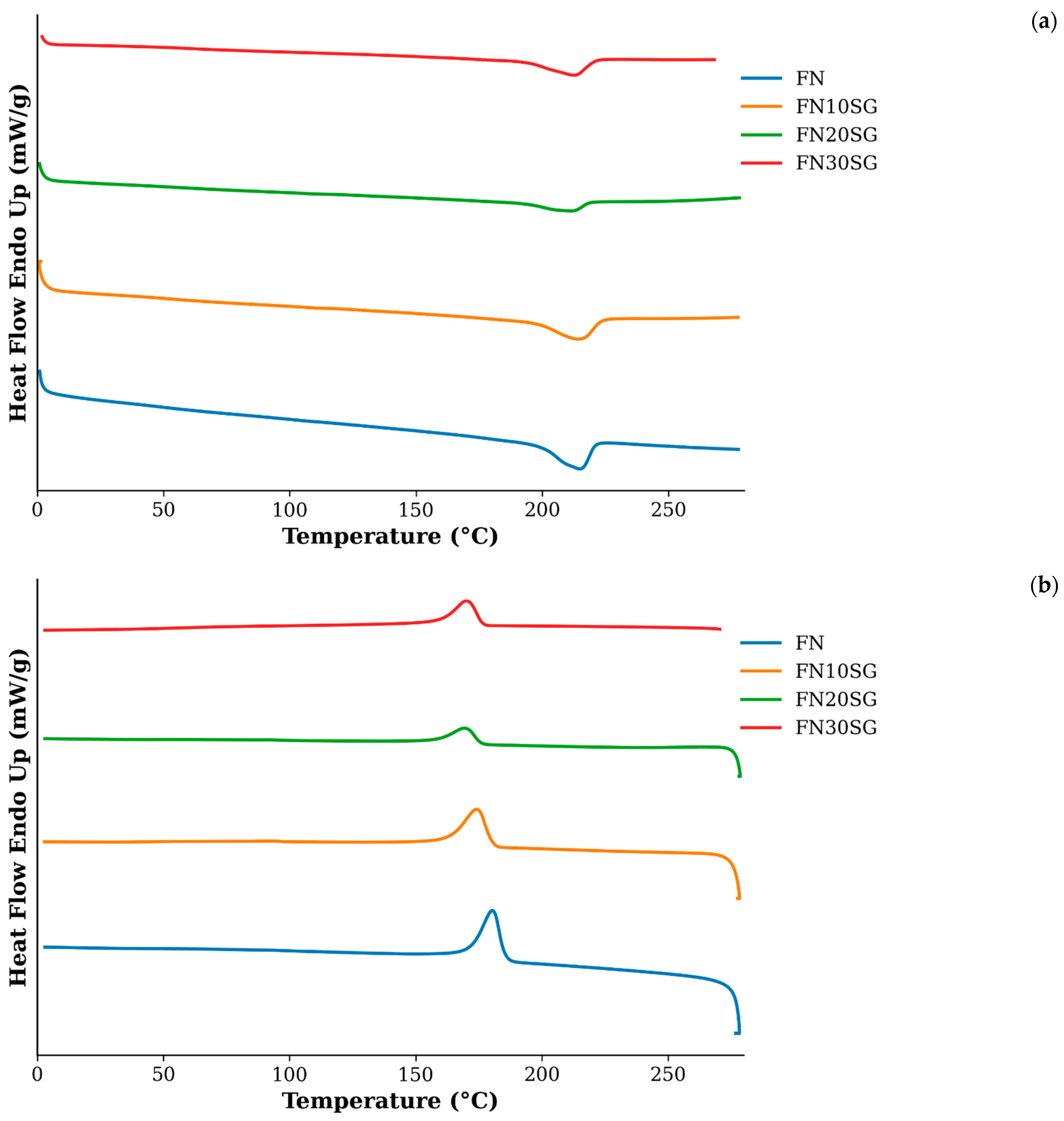



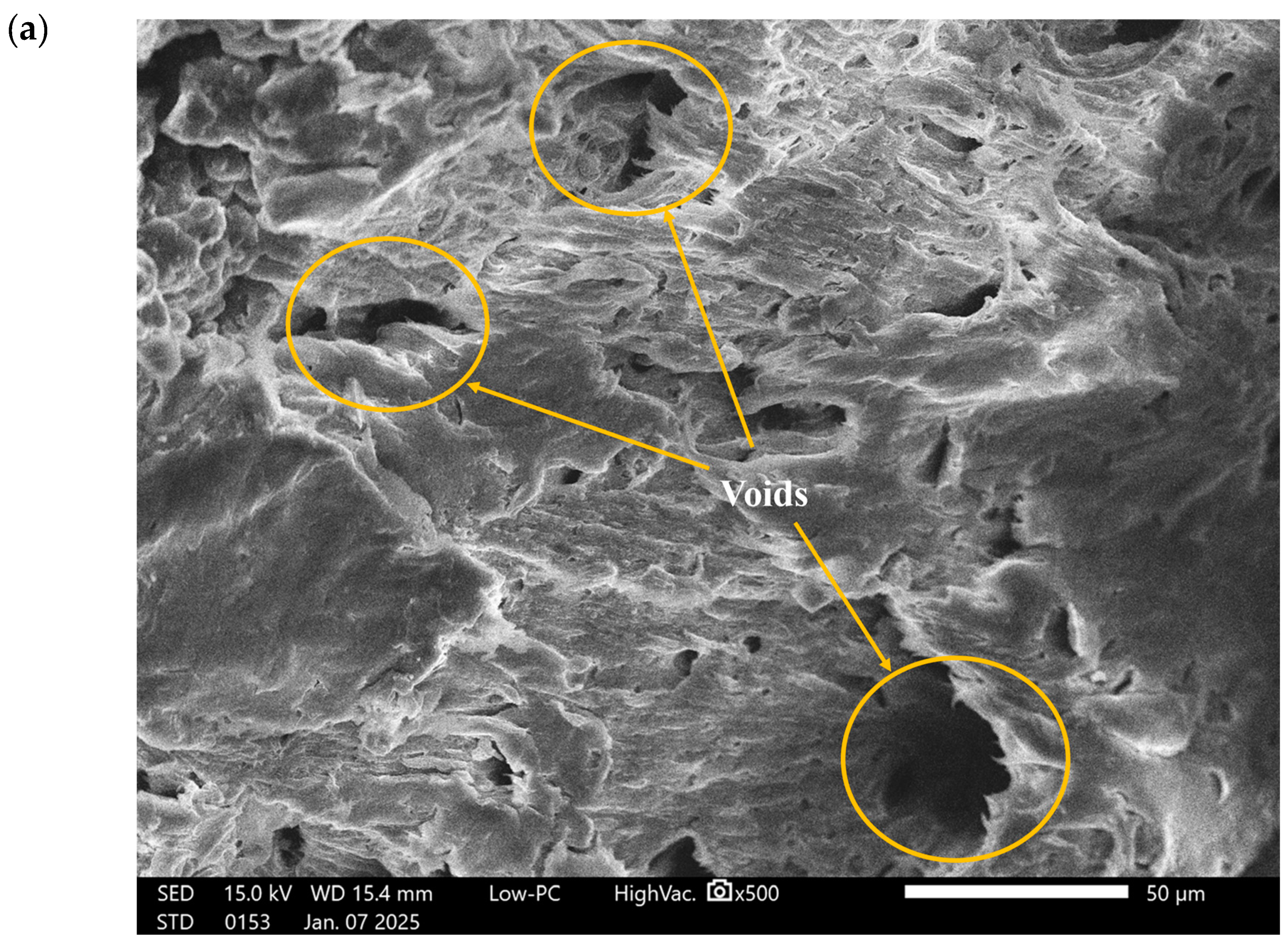

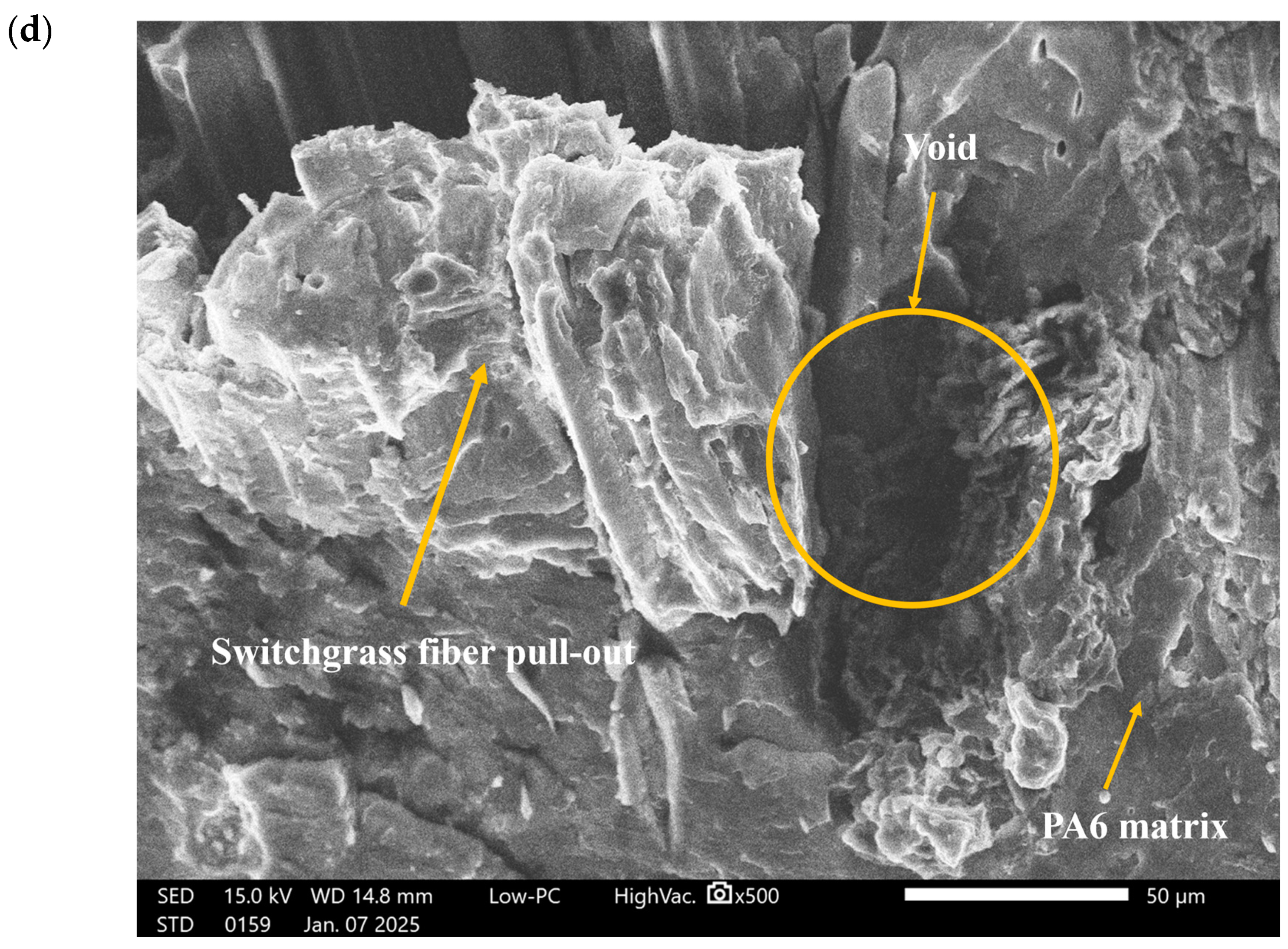
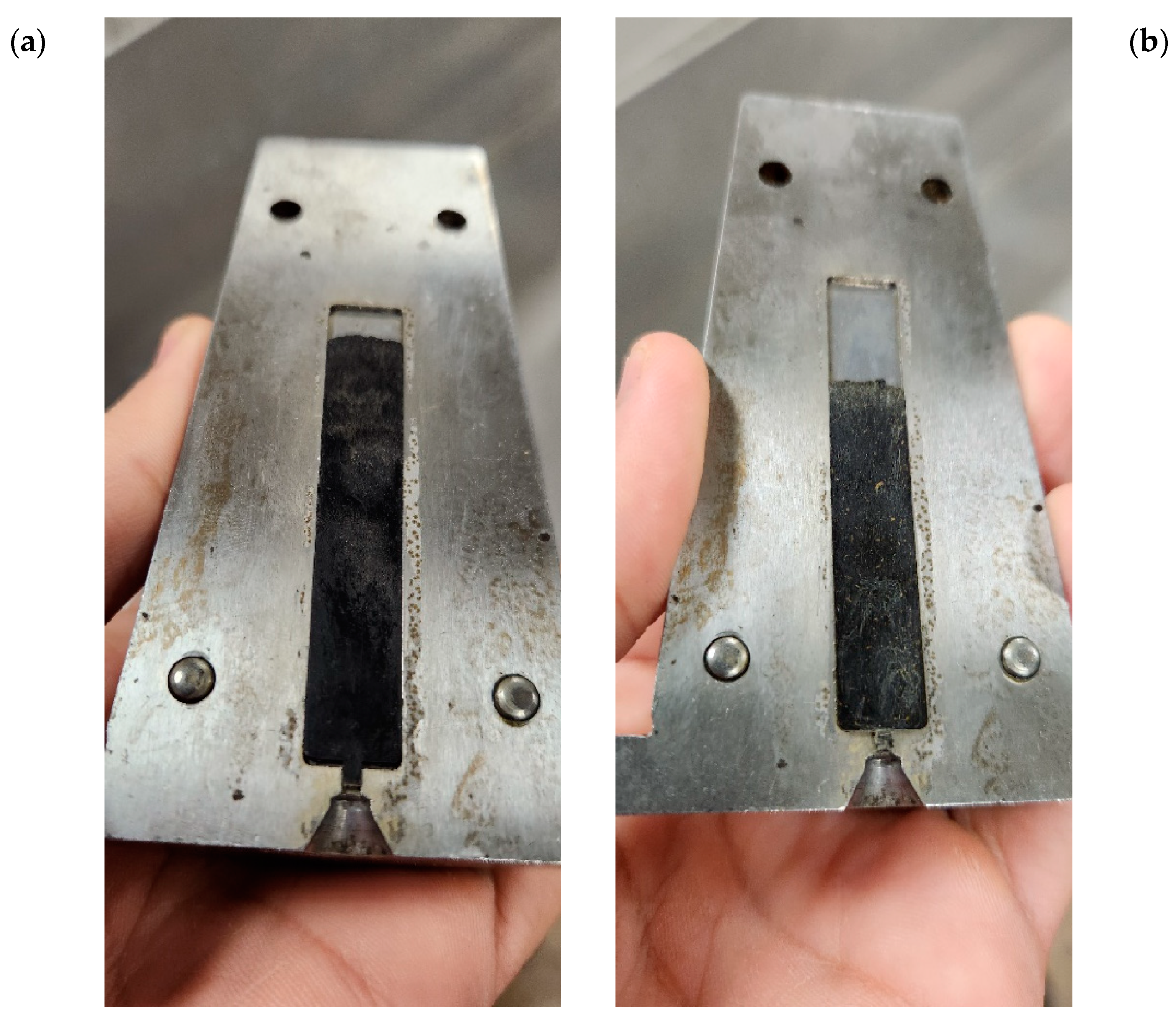
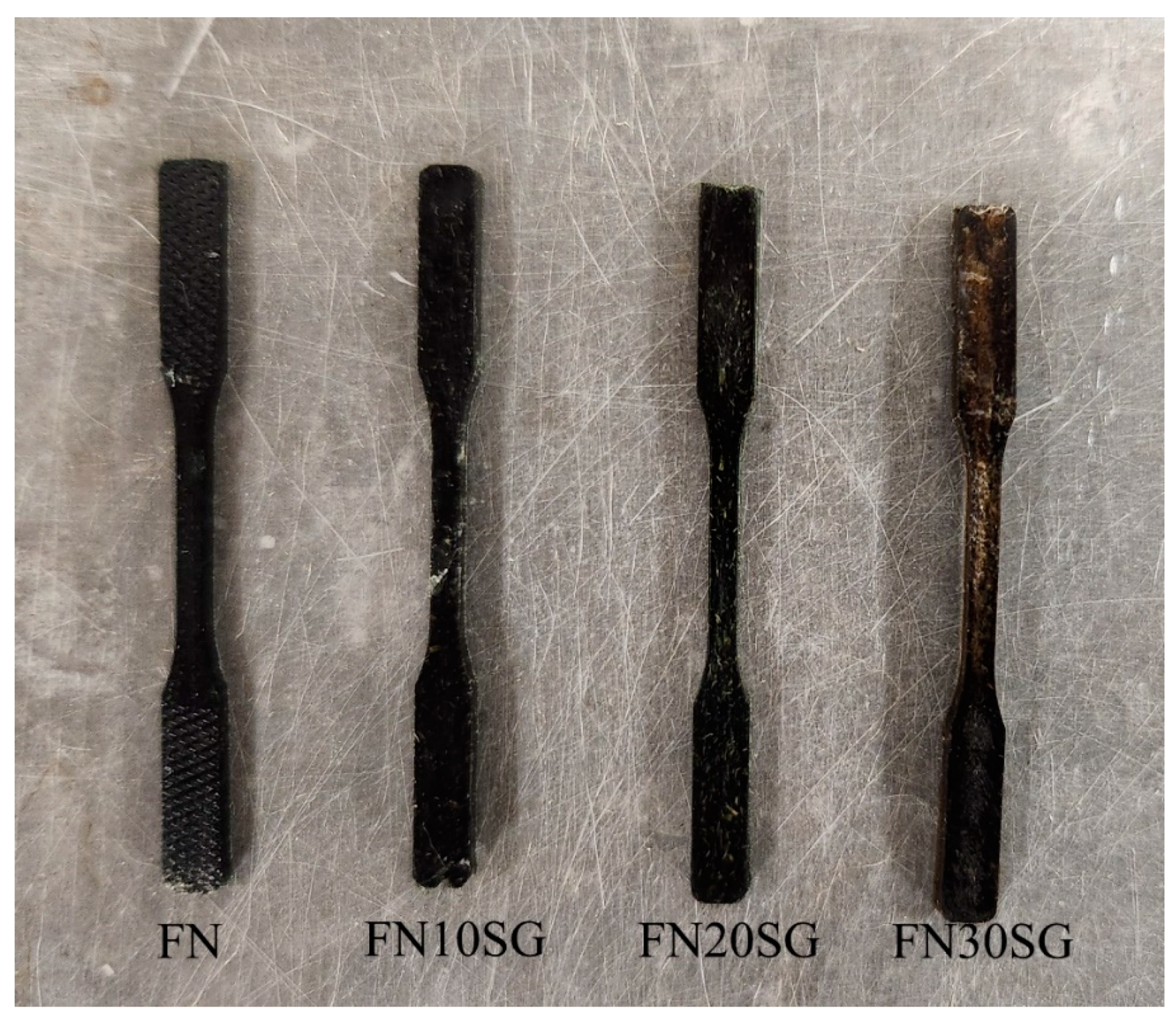
| Samples | ΔHm,PA6 (J/g) | XPA6 (%) | Tm,PA6 (°C) | Tc,PA6 (°C) |
|---|---|---|---|---|
| FN | 51 | 26.84 | 215 | 183 |
| FN10SG | 37 | 21.63 | 214 | 177 |
| FN20SG | 24 | 15.79 | 212 | 173 |
| FN30SG | 24 | 18.04 | 213 | 170 |
| Formulation | Tensile Strength (Mpa) | Young’s Modulus (Gpa) | Elongation at Break (%) | Sources |
|---|---|---|---|---|
| Experimental formulations | ||||
| FN | 54.58 ± 2.58 | 1.09 ± 0.28 | 49.00 ± 29.00 | - |
| FN10SG | 57.91 ± 4.73 | 2.14 ± 0.31 | 3.91 ± 1.60 | - |
| FN20SG | 56.97 ± 5.54 | 2.45 ± 0.18 | 2.38 ± 0.30 | - |
| FN30SG | 67.21 ± 3.77 | 2.46 ± 0.43 | 4.14 ± 0.44 | - |
| Neat commercial PA6 | ||||
| Nylatron MC 907/Ertalon 6 PLA PA6 | 88 | 3.6 | 25 | [55] |
| Nylon 6 Unfilled Natural NXH-01 NC | 72 | 3.1 | 60 | [56] |
| ESTOPLAST XU150BB01 | 55 | - | 10 | [57] |
| Formulation Type | Fiber Content (%) | Sample Name | Testing Temperature and Mass/Norm | MFR (g/10 min) | Fiber Type | Source |
|---|---|---|---|---|---|---|
| Experimental | 0 | FN | 235 °C 2.16 kg | 19.35 ± 1.94 | Switchgrass | --- |
| 10 | FN10SG | 235 °C 2.16 kg | 15.82 ± 2.59 | Switchgrass | --- | |
| 20 | FN20SG | 235 °C 2.16 kg | 8.77 ± 0.71 | Switchgrass | --- | |
| 30 | FN30SG | 235 °C 2.16 kg | 8.63 ± 0.8 | Switchgrass | --- | |
| Commercial | 0 | SINOPEC BL3240 | 230 °C 2.16 kg | 32.3 | Glass | [60] |
| 10 | SLOVAMID 6 GF 10 | 270 °C 0.325 kg | 3 | Glass | [61] | |
| 10 | Aclo Accutech Nylon 6 NY0730G10L | ASTM D1238 | 4 | Glass | [62] | |
| 20 | Aclo Accutech Nylon 6 NY0730G20L | ASTM D1238 | 6 | Glass | [63] |
| Compound | Cellulose | Hemicellulose | Lignin | Other (Ash, Protein, Extractive) |
|---|---|---|---|---|
| Weight percentage | 31.8 | 25 | 31.2 | 12 |
| Formulation | Fishing Nets | Switchgrass Fibers |
|---|---|---|
| FN | 100 | 0 |
| FN10SG | 90 | 10 |
| FN20SG | 80 | 20 |
| FN30SG | 70 | 30 |
| Parameter | Value |
|---|---|
| Extruder used | Thermo Fischer Process 11 Twin-screw extruder (Waltham, MA, USA) |
| Extruder temperature zone | 8 zones (Zone 1–4: 240 °C, Zone 5: 230 °C, Zone 6–7: 215 °C, Zone 8: 210 °C) |
| Die exit diameter | 2 mm |
| Screw speed | 120 RPM |
| Injection molding machine | HAAKETM MiniJet Pro (Waltham, MA, USA) |
| Molding time | 10 s |
| Molding pressure | 600 bars |
| Cylinder temperature | 245 °C |
| Mold temperature | Room temperature |
Disclaimer/Publisher’s Note: The statements, opinions and data contained in all publications are solely those of the individual author(s) and contributor(s) and not of MDPI and/or the editor(s). MDPI and/or the editor(s) disclaim responsibility for any injury to people or property resulting from any ideas, methods, instructions or products referred to in the content. |
© 2025 by the authors. Licensee MDPI, Basel, Switzerland. This article is an open access article distributed under the terms and conditions of the Creative Commons Attribution (CC BY) license (https://creativecommons.org/licenses/by/4.0/).
Share and Cite
Belmokhtar, Z.; Cousin, P.; Elkoun, S.; Robert, M. Mechanical and Thermal Properties of Recycled Fishing Net-Derived Polyamide 6/Switchgrass Fiber Composites for Automotive Applications. Recycling 2025, 10, 59. https://doi.org/10.3390/recycling10020059
Belmokhtar Z, Cousin P, Elkoun S, Robert M. Mechanical and Thermal Properties of Recycled Fishing Net-Derived Polyamide 6/Switchgrass Fiber Composites for Automotive Applications. Recycling. 2025; 10(2):59. https://doi.org/10.3390/recycling10020059
Chicago/Turabian StyleBelmokhtar, Zakariae, Patrice Cousin, Saïd Elkoun, and Mathieu Robert. 2025. "Mechanical and Thermal Properties of Recycled Fishing Net-Derived Polyamide 6/Switchgrass Fiber Composites for Automotive Applications" Recycling 10, no. 2: 59. https://doi.org/10.3390/recycling10020059
APA StyleBelmokhtar, Z., Cousin, P., Elkoun, S., & Robert, M. (2025). Mechanical and Thermal Properties of Recycled Fishing Net-Derived Polyamide 6/Switchgrass Fiber Composites for Automotive Applications. Recycling, 10(2), 59. https://doi.org/10.3390/recycling10020059







